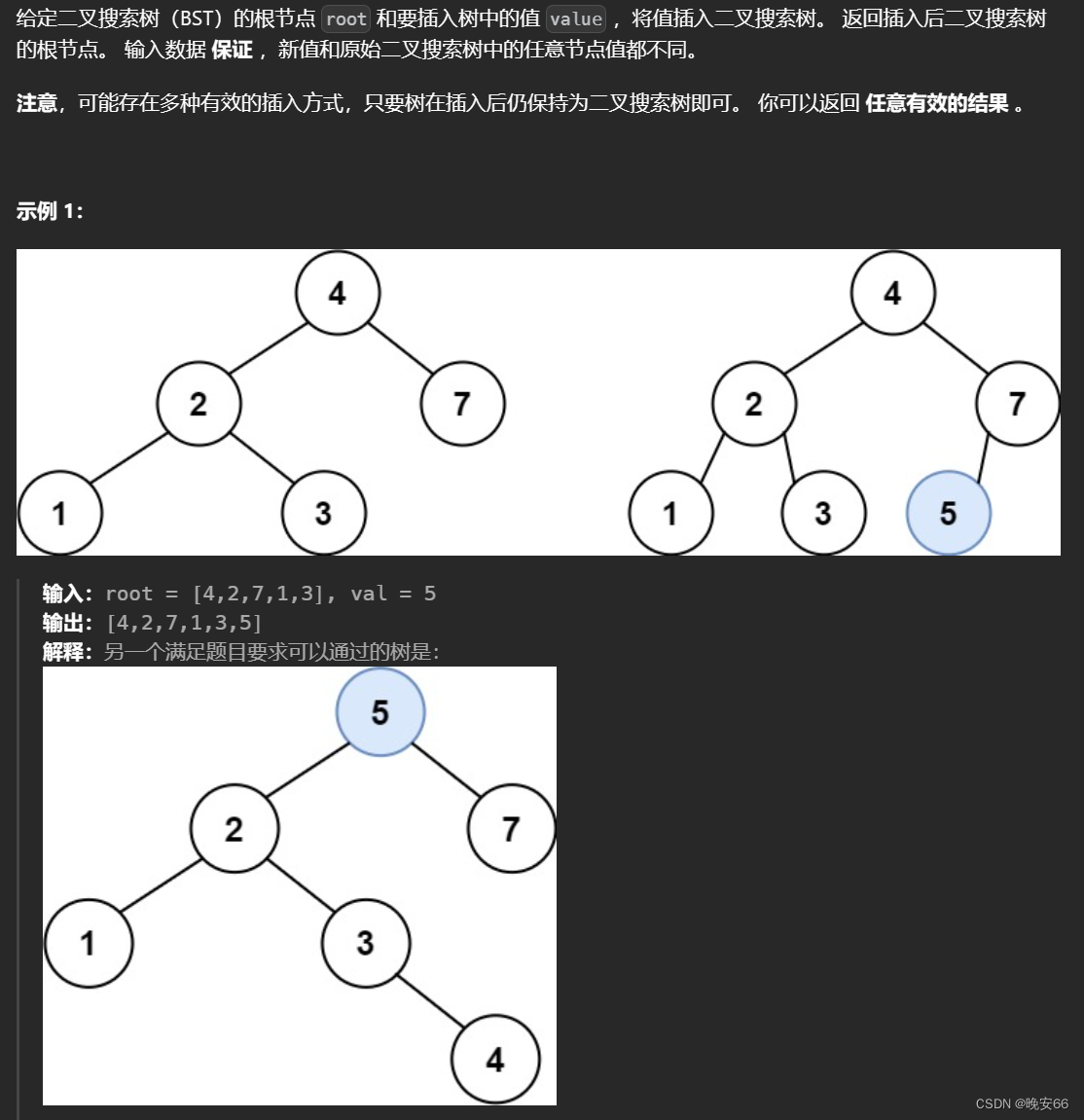所有的LeetCode题解索引,可以看这篇文章——【算法和数据结构】LeetCode题解。
一、题目

二、解法
思路分析:这道题关键在于分析插入值的位置,不论插入的值是什么(插入值和原有树中的键值都不相等),最终都是在空节点的位置插入,那么我们就可以确定递归的终止条件为空节点。因此只要和中间节点比较键值,确定递归是左子树还是右子树,递归完成后返回根节点。
程序如下:
class Solution {
public:
TreeNode* insertIntoBST(TreeNode* root, int val) {
if (root == NULL) {
TreeNode* cur = new TreeNode(val);
return cur;
}
if (root->val > val) root->left = insertIntoBST(root->left, val);
if (root->val < val) root->right = insertIntoBST(root->right, val);
return root;
}
};
三、完整代码
# include <iostream>
# include <vector>
# include <string>
# include <queue>
using namespace std;
// 树节点定义
struct TreeNode {
int val;
TreeNode* left;
TreeNode* right;
TreeNode() : val(0), left(nullptr), right(nullptr) {}
TreeNode(int x) : val(x), left(nullptr), right(nullptr) {}
TreeNode(int x, TreeNode* left, TreeNode* right) : val(x), left(left), right(right) {}
};
class Solution {
public:
TreeNode* insertIntoBST(TreeNode* root, int val) {
if (root == NULL) {
TreeNode* cur = new TreeNode(val);
return cur;
}
if (root->val > val) root->left = insertIntoBST(root->left, val);
if (root->val < val) root->right = insertIntoBST(root->right, val);
return root;
}
};
// 前序遍历迭代法创建二叉树,每次迭代将容器首元素弹出(弹出代码还可以再优化)
void Tree_Generator(vector<string>& t, TreeNode*& node) {
if (!t.size() || t[0] == "NULL") return; // 退出条件
else {
node = new TreeNode(stoi(t[0].c_str())); // 中
if (t.size()) {
t.assign(t.begin() + 1, t.end());
Tree_Generator(t, node->left); // 左
}
if (t.size()) {
t.assign(t.begin() + 1, t.end());
Tree_Generator(t, node->right); // 右
}
}
}
template<typename T>
void my_print(T& v, const string msg)
{
cout << msg << endl;
for (class T::iterator it = v.begin(); it != v.end(); it++) {
cout << *it << ' ';
}
cout << endl;
}
template<class T1, class T2>
void my_print2(T1& v, const string str) {
cout << str << endl;
for (class T1::iterator vit = v.begin(); vit < v.end(); ++vit) {
for (class T2::iterator it = (*vit).begin(); it < (*vit).end(); ++it) {
cout << *it << ' ';
}
cout << endl;
}
}
// 层序遍历
vector<vector<int>> levelOrder(TreeNode* root) {
queue<TreeNode*> que;
if (root != NULL) que.push(root);
vector<vector<int>> result;
while (!que.empty()) {
int size = que.size(); // size必须固定, que.size()是不断变化的
vector<int> vec;
for (int i = 0; i < size; ++i) {
TreeNode* node = que.front();
que.pop();
vec.push_back(node->val);
if (node->left) que.push(node->left);
if (node->right) que.push(node->right);
}
result.push_back(vec);
}
return result;
}
int main()
{
// 构建二叉树
vector<string> t = { "4", "2", "1", "NULL", "NULL", "3", "NULL", "NULL", "7", "NULL", "NULL" }; // 前序遍历
my_print(t, "目标树");
TreeNode* root = new TreeNode();
Tree_Generator(t, root);
vector<vector<int>> tree = levelOrder(root);
my_print2<vector<vector<int>>, vector<int>>(tree, "目标树:");
// 插入目标值
int val = 5;
Solution s;
TreeNode* result = s.insertIntoBST(root, val);
vector<vector<int>> tree1 = levelOrder(result);
my_print2<vector<vector<int>>, vector<int>>(tree1, "目标树:");
system("pause");
return 0;
}
end
























 323
323

 被折叠的 条评论
为什么被折叠?
被折叠的 条评论
为什么被折叠?










